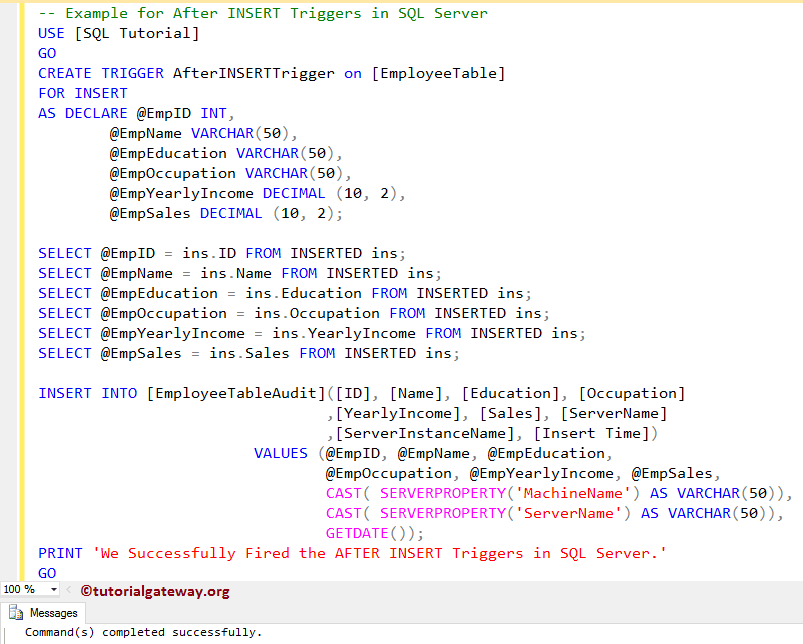Mssql Insert Return Generated Keys
 -->
-->
Join Simon Allardice for an in-depth discussion in this video Using the OUTPUT clause to return inserted keys and GUIDs, part of SQL Server 2008 Essential Training. But in the INSERT example we saw before, all that I'm inserting is aParentProductCategoryID and a name, because the guids and the identities arebeing generated for us. SQL - Inserting a row and returning primary key. Ask Question Asked 8 years. Will return you the last generated identity value within your current scope: SELECT SCOPEIDENTITY AS NewID. How to use Dapper for bulk insert with foreign keys?
Is a system function that returns the last-inserted identity value.
Mssql Insert Return Generated Keys In Word
Syntax
Return Types
numeric(38,0)
Remarks
After an INSERT, SELECT INTO, or bulk copy statement is completed, @@IDENTITY contains the last identity value that is generated by the statement. If the statement did not affect any tables with identity columns, @@IDENTITY returns NULL. If multiple rows are inserted, generating multiple identity values, @@IDENTITY returns the last identity value generated. If the statement fires one or more triggers that perform inserts that generate identity values, calling @@IDENTITY immediately after the statement returns the last identity value generated by the triggers. If a trigger is fired after an insert action on a table that has an identity column, and the trigger inserts into another table that does not have an identity column, @@IDENTITY returns the identity value of the first insert. The @@IDENTITY value does not revert to a previous setting if the INSERT or SELECT INTO statement or bulk copy fails, or if the transaction is rolled back.
Failed statements and transactions can change the current identity for a table and create gaps in the identity column values. The identity value is never rolled back even though the transaction that tried to insert the value into the table is not committed. For example, if an INSERT statement fails because of an IGNORE_DUP_KEY violation, the current identity value for the table is still incremented.
@@IDENTITY, SCOPE_IDENTITY, and IDENT_CURRENT are similar functions because they all return the last value inserted into the IDENTITY column of a table.
@@IDENTITY and SCOPE_IDENTITY return the last identity value generated in any table in the current session. However, SCOPE_IDENTITY returns the value only within the current scope; @@IDENTITY is not limited to a specific scope.
IDENT_CURRENT is not limited by scope and session; it is limited to a specified table. IDENT_CURRENT returns the identity value generated for a specific table in any session and any scope. For more information, see IDENT_CURRENT (Transact-SQL).
The scope of the @@IDENTITY function is current session on the local server on which it is executed. This function cannot be applied to remote or linked servers. To obtain an identity value on a different server, execute a stored procedure on that remote or linked server and have that stored procedure (which is executing in the context of the remote or linked server) gather the identity value and return it to the calling connection on the local server.
Replication may affect the @@IDENTITY value, since it is used within the replication triggers and stored procedures. @@IDENTITY is not a reliable indicator of the most recent user-created identity if the column is part of a replication article. You can use the SCOPE_IDENTITY() function syntax instead of @@IDENTITY. For more information, see SCOPE_IDENTITY (Transact-SQL)
Note
The calling stored procedure or Transact-SQL statement must be rewritten to use the SCOPE_IDENTITY() function, which returns the latest identity used within the scope of that user statement, and not the identity within the scope of the nested trigger used by replication.
Examples
The following example inserts a row into a table with an identity column (LocationID) and uses @@IDENTITY to display the identity value used in the new row.
See Also
System Functions (Transact-SQL)
CREATE TABLE (Transact-SQL)
IDENT_CURRENT (Transact-SQL)
INSERT (Transact-SQL)
SCOPE_IDENTITY (Transact-SQL)
SELECT (Transact-SQL)
The Microsoft JDBC Driver for SQL Server supports the optional JDBC 3.0 APIs to retrieve automatically generated row identifiers. The main value of this feature is to provide a way to make IDENTITY values available to an application that is updating a database table without a requiring a query and a second round-trip to the server.
Because SQL Server doesn't support pseudo columns for identifiers, updates that have to use the auto-generated key feature must operate against a table that contains an IDENTITY column. SQL Server allows only a single IDENTITY column per table. The result set that is returned by getGeneratedKeys method of the SQLServerStatement class will have only one column, with the returned column name of GENERATED_KEYS. If generated keys are requested on a table that has no IDENTITY column, the JDBC driver will return a null result set.
As an example, create the following table in the sample database:
In the following example, an open connection to the sample database is passed in to the function, an SQL statement is constructed that will add data to the table, and then the statement is run and the IDENTITY column value is displayed.